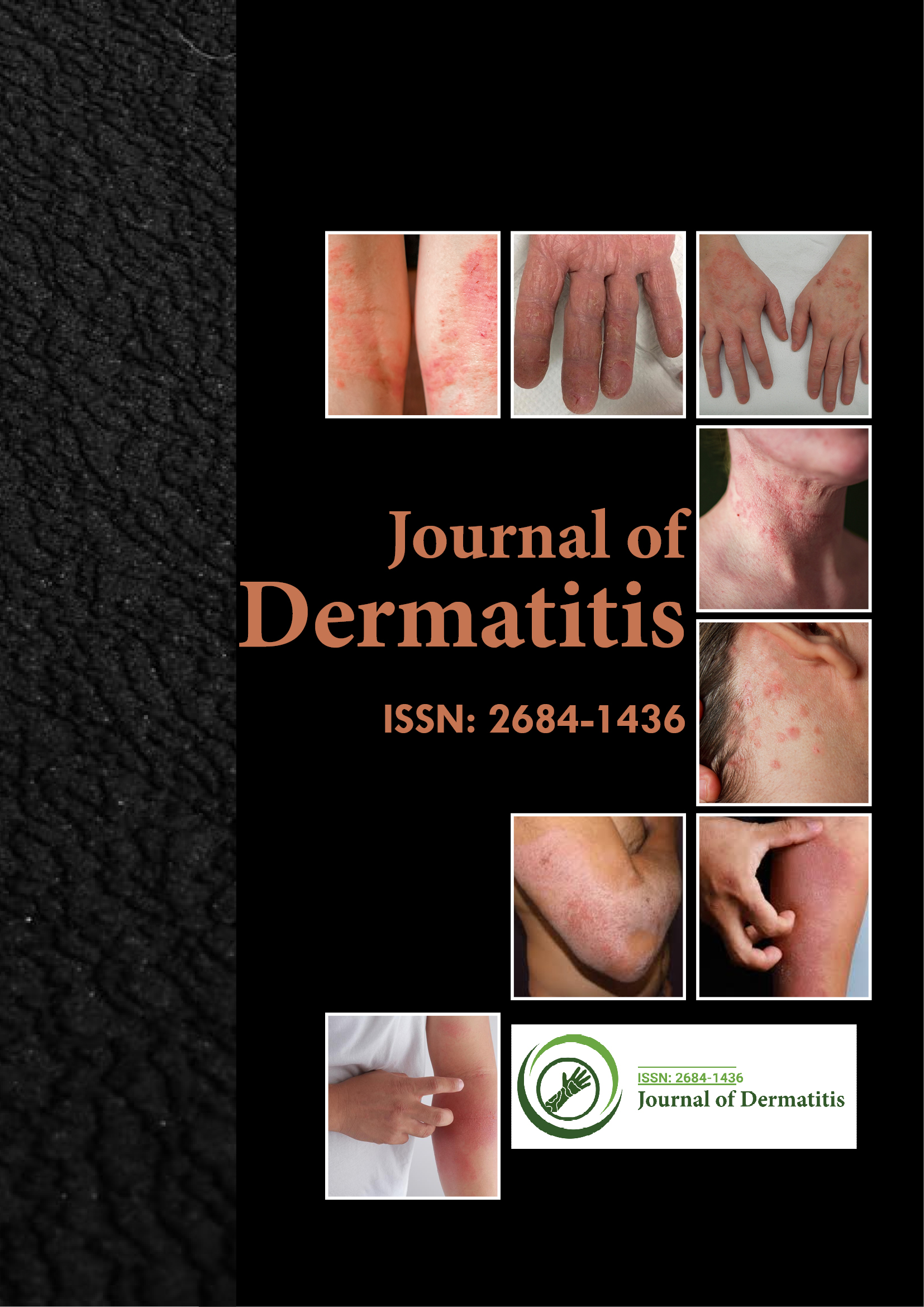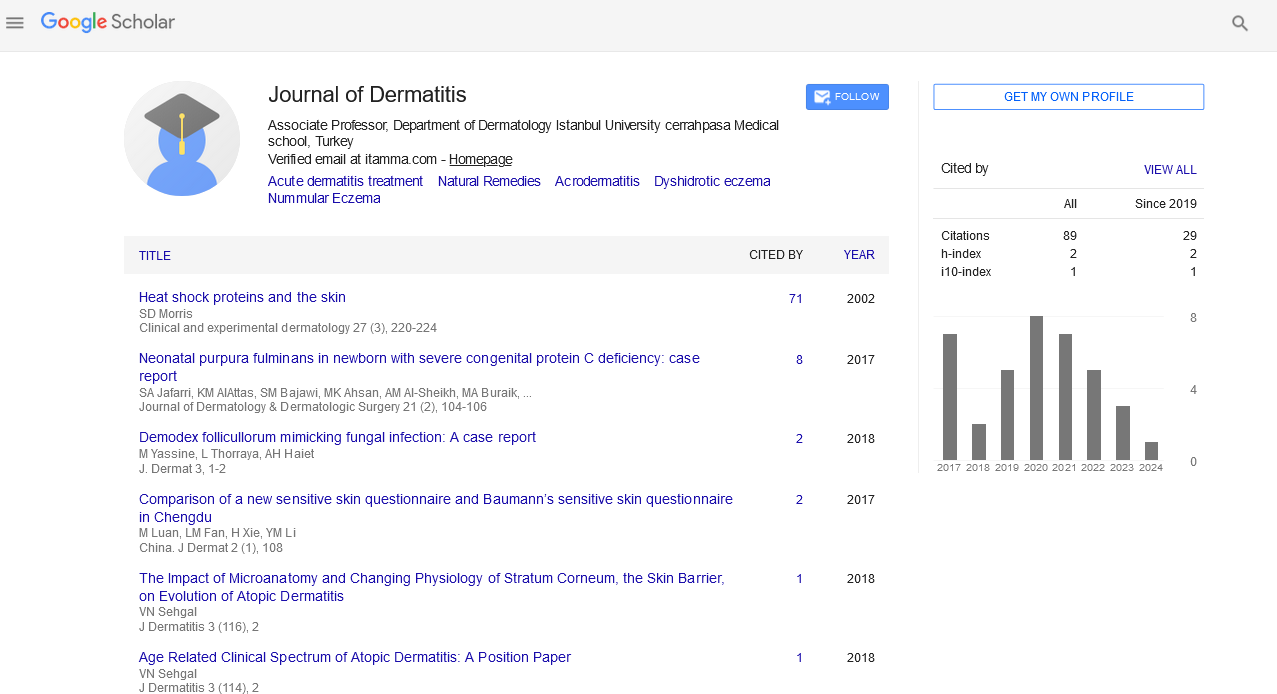Indexed In
- RefSeek
- Hamdard University
- EBSCO A-Z
- Euro Pub
- Google Scholar
Useful Links
Share This Page
Journal Flyer

Open Access Journals
- Agri and Aquaculture
- Biochemistry
- Bioinformatics & Systems Biology
- Business & Management
- Chemistry
- Clinical Sciences
- Engineering
- Food & Nutrition
- General Science
- Genetics & Molecular Biology
- Immunology & Microbiology
- Medical Sciences
- Neuroscience & Psychology
- Nursing & Health Care
- Pharmaceutical Sciences
Commentary - (2023) Volume 8, Issue 5
Mechanism of Hypnodermatology: Merging Mind and Skin for Healing
Jianbing Laurikko*Received: 17-Aug-2023, Manuscript No. JOD-23-23482; Editor assigned: 21-Aug-2023, Pre QC No. JOD-23-23482 (PQ); Reviewed: 04-Sep-2023, QC No. JOD-23-23482; Revised: 11-Sep-2023, Manuscript No. JOD-23-23482 (R); Published: 19-Sep-2023, DOI: 10.35248/2684-1436.23.8.214
Description
In the scope of modern medicine, the interplay between mind and body has gained significant attention, giving rise to innovative approaches that control the power of the mind to influence physiological processes. One such intresting discipline that exemplifies this connection is hypnodermatology, a therapeutic technique that bridges the gap between dermatology and hypnosis. By consistent merging psychological intervention with dermatological treatments, hypnodermatology a unique pathway to enhance the healing of various skin conditions. This article delves into the mechanism underlying hypnodermatology, exploring how the mind's influence on the skin can contribute to holistic well-being.
Understanding the mind-body connection
The fundamental assumption of hypnodermatology rests on the intricate connection between the mind and the body. Research has repeatedly demonstrated how emotions, stress, and psychological states can impact the skin's health. Conditions like psoriasis, eczema, and acne often flare up during periods of heightened stress, pointing to the undeniable link between the brain and the skin. This mind-body connection forms the foundation of hypnodermatology, which seeks to control the power of the mind to positively influence skin conditions.
The role of hypnosis
Hypnosis, a trance-like state of focused attention and heightened suggestibility, is a central tool in hypnodermatology. When individuals are in a hypnotic state, their minds become more receptive to positive suggestions and imagery. This is where the healing process begins. By inducing a hypnotic state, a trained hypnodermatologist can guide patients through suggestions that specifically target their skin conditions. These suggestions can range from reducing inflammation and itching to accelerating wound healing. The power of these suggestions lies in their ability to tap into the mind's influence over physiological responses.
Neurological mechanisms
The neurological mechanisms behind hypnodermatology are intricate. When a person is hypnotized, there is a shift in brain activity, with alterations in patterns of neural firing. This shift can lead to the release of neurotransmitters and hormones that impact the body's immune response and inflammatory pathways. For instance, the suggestion of reduced itching can trigger the brain to release endorphins, natural pain-relieving chemicals that can alleviate discomfort and itching sensations.
Stress reduction and immune modulation
Stress is a well-known trigger for many skin conditions. Hypnodermatology addresses this by incorporating relaxation techniques that not only alleviate stress but also modulate the immune response. Stress hormones like cortisol can exacerbate inflammation and hinder the body's natural healing processes. Through hypnosis, patients can learn to manage stress and anxiety, leading to lower cortisol levels and a more balanced immune system. By reducing stress-related flare-ups, hypnodermatology aids in promoting healthier skin.
Visualization and cellular healing
One of the intriguing aspects of hypnodermatology is its use of visualization techniques. During hypnosis, patients are guided to visualize their skin healing, renewing, and returning to a healthier state. This visualization isn't merely a mental exercise; studies have shown that the brain's responses to these vivid mental images can trigger actual physiological changes at the cellular level. This phenomenon, known as the placebo effect, demonstrates how the mind's influence can extend far beyond cognitive processes, impacting the body's physical responses.
Patient empowerment and compliance
Hypnodermatology places patients at the center of their healing empowering them to take an active role in their treatment. By fostering a sense of control and self-efficacy, hypnodermatology enhances patient compliance with treatment regimens. This is particularly important in dermatology, where adherence to medication and skincare routines can significantly impact outcomes. The psychological empowerment gained through hypnosis can translate into better adherence and, consequently, improved skin health.
In conclusion, the mechanism of hypnodermatology embodies the intricate between the mind and the skin. By controlling the power of hypnosis, positive suggestions, and visualization, this innovative approach holds the potential to enhance the healing of various skin conditions. Through stress reduction, immune modulation, and cellular healing, hypnodermatology exemplifies the integration of psychology and dermatology for holistic wellbeing. As our understanding of the mind-body connection continues to deepen, hypnodermatology stands as an example of the remarkable ways in which the power of the mind can be controlled for physical healing.
Citation: Laurikko J (2023) Mechanism of Hypnodermatology: Merging Mind and Skin for Healing. J Dermatitis. 8:214.
Copyright: © 2023 Laurikko J. This is an open-access article distributed under the terms of the Creative Commons Attribution License, which permits unrestricted use, distribution, and reproduction in any medium, provided the original author and source are credited.

